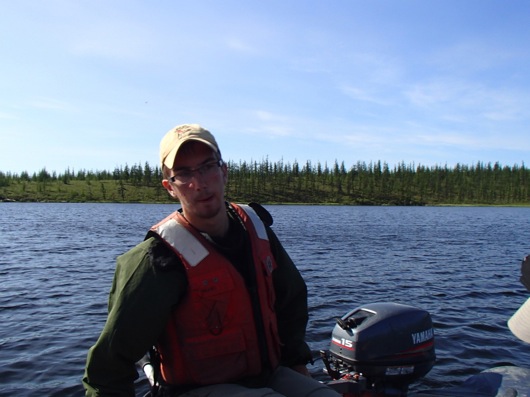I had a chance to talk with Seth for a couple of hours on one of the first days at the station as we waited for a sampling team at Shuch’ye Lake. Immediately, I was impressed by Seth’s intellect and drive. Not only is he majoring in both chemistry and biology at St. Olaf College, he is also a bicycle racer there. We also had a common interest as Eagle Scouts, along with my Polaris Project roommate, Dave Mayer from Clark University!
 Three Eagle Scouts hold a Pleistocene bison skull recovered at Duvannyi Yar. (L to R) Mark Paricio, Seth Spawn, Dave Mayer.
Three Eagle Scouts hold a Pleistocene bison skull recovered at Duvannyi Yar. (L to R) Mark Paricio, Seth Spawn, Dave Mayer.
Seth’s Research
Seth’s research focuses on the photodegradation of dissolved organic carbon in the thermokarst lakes near the science station. The photodegradation (“photo-” refers to “light” and “-degradation” refers to breaking down) he is interested in refers to the role of ultraviolet and visible sunlight in breaking down carbon containing molecules into carbon dioxide near the top few meters of the lakes where this sunlight can penetrate. The carbon dioxide gas is then either released to the atmosphere or transported through the waterways.
This morning, I went out with Seth and Dr. Karen Frey of Clark University to take the last few samples of Seth’s experiment and to collect an ingenious sampling platform of Seth’s creation that held bags of water at various depths for a week so the photodegradation at each level can be determined and compared.
 Seth guides our raft out to the sampling area on Shuch’ye Lake.
Seth guides our raft out to the sampling area on Shuch’ye Lake.
Field Science Doesn’t Always go the Way You Planned It
Although most aspects of Seth’s experiment went well, the wood he used to make his sampling platform was old, had become too waterlogged, and sunk to the bottom of the lake. Despite this setback, Seth still had many other types of data he had collected and will proceed to process for his project. Sometimes, the resources we have just don’t hold up to the environmental conditions they encounter. This was a good lesson for all of us and if this portion of Seth’s experiment is reproduced next year, he already had several ideas to improve the sampling platform.
Mr. Versatile
Getting to know and work with Seth has been a pleasure over the last four weeks. He always has a new perspective to add to our discussions and is willing to try out new experiences. This afternoon, Seth and I joined Lindsey Parkinson and Mike Loranty to go out to the forest and take cores samples of trees for one of Mike’s projects. Seth was a natural tree corer!
 Seth takes a core from a very old larch tree.
Seth takes a core from a very old larch tree.
One of the fond memories I will have of visiting Siberia will be watching Seth fly fish on a tributary stream when we visited the tundra last week. He caught a half dozen Arctic Grayling fish in about an hour!
 Seth made the most of his hour-long opportunity to go fly fishing on the Northern Siberian Tundra.
Seth made the most of his hour-long opportunity to go fly fishing on the Northern Siberian Tundra.
His poise and thoughtfulness will take him far in science!
Stay curious my friends! - Mark Paricio
Don’t forget, you can follow the blogs of the students on the Polaris Project with me at: http://www.thepolarisproject.org.

